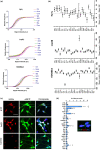Chemically induced senescence in human stem cell-derived neurons promotes phenotypic presentation of neurodegeneration
- PMID: 34953016
- PMCID: PMC8761019
- DOI: 10.1111/acel.13541
Chemically induced senescence in human stem cell-derived neurons promotes phenotypic presentation of neurodegeneration
Abstract
Modeling age-related neurodegenerative disorders with human stem cells are difficult due to the embryonic nature of stem cell-derived neurons. We developed a chemical cocktail to induce senescence of iPSC-derived neurons to address this challenge. We first screened small molecules that induce embryonic fibroblasts to exhibit features characteristic of aged fibroblasts. We then optimized a cocktail of small molecules that induced senescence in fibroblasts and cortical neurons without causing DNA damage. The utility of the "senescence cocktail" was validated in motor neurons derived from ALS patient iPSCs which exhibited protein aggregation and axonal degeneration substantially earlier than those without cocktail treatment. Our "senescence cocktail" will likely enhance the manifestation of disease-related phenotypes in neurons derived from iPSCs, enabling the generation of reliable drug discovery platforms.
Keywords: cell senescence; disease modeling; neural differentiation; neurodegeneration.
© 2021 The Authors. Aging Cell published by Anatomical Society and John Wiley & Sons Ltd.
Conflict of interest statement
RNA‐seq data have been deposited in the Gene Expression Omnibus (GEO) under accession GSE141028. The authors declare no competing financial interests. Correspondence, and requests for materials should be addressed to S‐C.Z. (
Figures







References
-
- Afonso, P. , Auclair, M. , Boccara, F. , Vantyghem, M.‐C. , Katlama, C. , Capeau, J. , Vigouroux, C. , & Caron‐Debarle, M. (2016). LMNA mutations resulting in lipodystrophy and HIV protease inhibitors trigger vascular smooth muscle cell senescence and calcification: Role of ZMPSTE24 downregulation. Atherosclerosis, 245, 200–211. 10.1016/j.atherosclerosis.2015.12.012 - DOI - PubMed
-
- Bilican, B. , Serio, A. , Barmada, S. J. , Nishimura, A. L. , Sullivan, G. J. , Carrasco, M. , Phatnani, H. P. , Puddifoot, C. A. , Story, D. , Fletcher, J. , Park, I. H. , Friedman, B. A. , Daley, G. Q. , Wyllie, D. J. , Hardingham, G. E. , Wilmut, I. , Finkbeiner, S. , Maniatis, T. , Shaw, C. E. , & Chandran, S. (2012). Mutant induced pluripotent stem cell lines recapitulate aspects of TDP‐43 proteinopathies and reveal cell‐specific vulnerability. Proceedings of the National Academy of Sciences of the United States of America, 109, 58035808. 10.1073/pnas.1202922109 - DOI - PMC - PubMed
Publication types
MeSH terms
Grants and funding
LinkOut - more resources
Full Text Sources
Medical
Molecular Biology Databases
Research Materials
Miscellaneous

